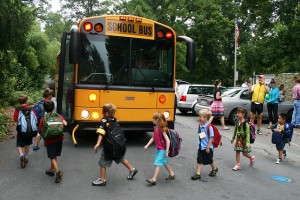Safety is Cool on the Way to School
Sharing is caring!
It’s that time of year again! However your child chooses to get to and from school, it is important to stay safe during the journey. When it comes to safety, pedestrians, bikers, and drivers should always keep a close eye on the surrounding environment and follow traffic signals.
Did You Know?
- In the United States, 61 kids are hit by cars every day and unintentional pedestrian injuries are the fifth leading cause of injury-related death for children ages 5 to 19.
- More children ages 5 to 14 are seen in emergency rooms for bike-related injuries than any other sport. Wearing a helmet can reduce risk of severe brain injury by 88%, yet less than half of children age 14 and under use them.
- School buses are designed to be safer than passenger vehicles in avoiding crashes and preventing injury, but the greatest risk occurs when approaching or leaving a bus, not riding in one.
Please review the following pedestrian, bike, and school bus safety tips to ensure that your child stays out of harm’s way going to and from school.
Walk Safely
- Always walk on sidewalks or paths.
- Cross the street at street corners that have traffic signals and crosswalks.
- If there are no sidewalks, walk facing traffic and as far away from vehicles as possible.
- Always look left, right, and left again before crossing the street. Kids up to age 10 should always cross the street with an adult.
- Always walk, never run, when crossing the street.
- Make eye contact with drivers before crossing in front of them and watch for cars that are turning or backing up.
- Don’t use electronic devices or look down when crossing the street or in a high traffic area.
- Never run out into the street or cross between parked cars.
Bike Safely
- Make sure your child has the right size helmet and wears it every time when riding, skating or scooting. It is the single most effective safety device available to reduce head injury and death from bicycle crashes. Safe Kids recommends kids take the Helmet Fit Test.
- Ride on the right side of the road, with traffic, not against it and stay as far to the right side as possible.
- Use appropriate hand signals and follow traffic signals, stopping at all stop signs and stoplights.
- Before entering a street or crossing an intersection, look left, right, then left again.
- Before turning left, look back and yield to traffic coming from behind.
- Do not ride at night if possible.
- When riding at dusk, dawn, or at night, make sure the bike has working reflectors and wear bright clothing and/or reflective materials to stay visible to others on the road.
- Avoid potholes, cracks in the road, slippery surfaces, or anything else that could cause loss of control.
Bus Safely
- Always walk children to and from the bus stop, wait with them for it to arrive, and pick them up when it returns.
- Stand three big steps away from the curb when the bus arrives and wait until it comes to a complete stop to get on and off.
- Be extra careful in the “danger zone,” which is 10 feet in front, behind, and on each side of the bus.
- When crossing the street after exiting the bus, take five large steps in front of the bus, look left, right, then left again, and cross when the driver indicates that it is safe.
Drive Carefully
- Be alert in residential areas or school zones and watch for children in and around the road.
- Always give pedestrians the right of way and look both ways before turning.
- Eliminate any distractions inside your car so you can fully concentrate on driving.
- Enter and exit driveways slowly and carefully.
- Follow the speed limit and slow down in school zones or near bus stops.
- Always slow down and stop if you are driving near a school bus with flashing yellow or red lights. This means that the bus is preparing to or has already stopped, and that children will be getting on or off.
Tagged with: back to school • bike safety • child passenger safety • child safety • helmets • injury prevention • safe kids • school bus safety
Join us on Facebook


